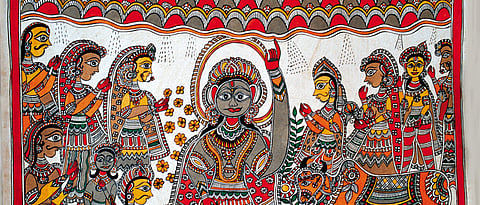
- Destinations
- Experiences
- Stay
- What's new
- Editor’s Picks
- Responsible Tourism
- CampaignsCampaigns
- Subscribe

Most people have heard of Madhubani in the context of Madhubani paintings (also known as Mithila paintings), a folk art form that is believed to have originated in the 14th century, though some myth enthusiasts date it to the time of the Ramayana. Brought to public attention after independence, the art form grew wildly popular and now adorns drawing rooms and galleries across the world. The district of Madhubani, which is home to some of the most popular artists, was formed in 1972 and borders Nepal. There are no tourist spots in Madhubani as such. However, many people visit the villages of Ranti and Jitwarpur to see the Mithila painters in action and learn more about their art form. There are also a few palaces of the Darbhanga Raj in this area, which now lie in ruins.
A plant takes root in a pot and bewilderingly but harmoniously grows into a vibrant forest, engulfing the entire canvas. A Madhubani painting combining myths, imagination and creativity is a powerful image, glowing with beauty even though it consists of effortless two-dimensional line drawings filled with bright colours, depicting simple themes and motifs. Madhubanis mainly depict figures and events from Hindu mythology and nature. The paintings have a long tradition, and this shows in the way they bring forth a deep bond between the artist and the subject.
The name of this art comes from Madhubani town in north Bihar, in the villages around which the art is practised. The paintings are also called Mithila art, after the name of this cultural region of Bihar.
Traditionally, this art was practised by women. It was done on mud walls of their homes, which had been freshly plastered, often on special occasions such as marriage, birth and festivals. The brush was made of cotton and bamboo colours were sourced from cow dung, soot, turmeric, pollen, flowers
Now men paint as well the painting is more and more done on paper, cloth and canvas, and is for commercial purposes. A drought in this region in the late 1960s is said to have acted as a catalyst for the women to commercialise their art, as a source of non-agricultural income.
In a typical Madhubani, you are likely to find depictions of the sun, moon, the tulsi plant, fish, birds... and deities like Durga, Shiva, Krishna, Rama, Lakshmi.... Other motifs are bamboo groves, a pair of birds facing each other and entwined snakes. Scenes from a royal court and social occasions such as a wedding may also be painted.
Scholars divide the broader rubric of Madhubani paintings into different traditions Kayastha, Brahmin and Tattoo. The Kayastha tradition mainly uses black and red colours to decorate the nuptial chamber with symbols of pleasure and fertility like parrots, tortoises and birds. The Brahmin tradition is much more colourful and depicts mythology. The Tattoo paintings emerge from a repetition of the same motif, pattern or image.
Madhubani, the site of ancient Mithila, is also associated with the legendary poet, Kalidasa, regarded as the greatest poet in Sanskrit literature. It is thought that the poet was born in Uchaith.
Around Madhubani
Rajnagar Fort
Rajnagar lies 12 kilometres north of Madhubani and has the ruins of the old Rajnagar Fort. Rameshwar Singh wanted to shift the headquarters of the Darbhanga Raj from Darbhanga to Rajnagar and so he built many lavish palaces, temples, gardens and tanks here. Most of these structures were damaged during the earthquake of 1934, that has irreparably harmed these formerly majestic buildings. Among the ruins, you can see the Navlakha Palace and Ram Janaki temple. The Kali temple, made of white marble, is still well preserved and a popular tourist spot.
Getting There
Madhubani is located in northern Bihar, bound in the north by Nepal's terai and byDarbhanga in the south, Sitamarhi in the west and Supaul in the east. It's about 195km from Patna (a 5-hour drive) and about 126km from Muzaffarpur (a 4-hour drive).
Where to Stay &Eat
Most of the hotels are located close to the railway station. Hotel Raj Vilas (Cell 0920317250 Tariff 800-1,550) offers air-conditioned rooms with attached bathrooms. Madhuyamini Inn (Tel 06276227160, Cell 09801019032 Tariff 1,350-3,100) has air-conditioned and non air-conditioned single as well as double rooms. The hotel also offers complimentary Wi-Fi. Hotel Nand (Tel 224263, Tariff 700-1,650) is another option with single and double rooms. Close to the Ram Janaki Mandir, Hotel Sumantha (Tel 222156, Tariff 450-1,000) offers rooms without air-conditioning. Hotel Yuvraj (Tel 222595 Cell 095768 31143 Tariff 550) is on Station Road and has rooms with attached bathrooms. Hotel DG (Tel 22726566 Tariff 1,800-2,250), near Shankar Chowk, also has standard facilities.
Tip It is advisable to eat at your hotels in-house restaurant. All of the hotels mentioned above have restaurants that serve both veg and non-veg fare, including some Chinese dishes as well.
